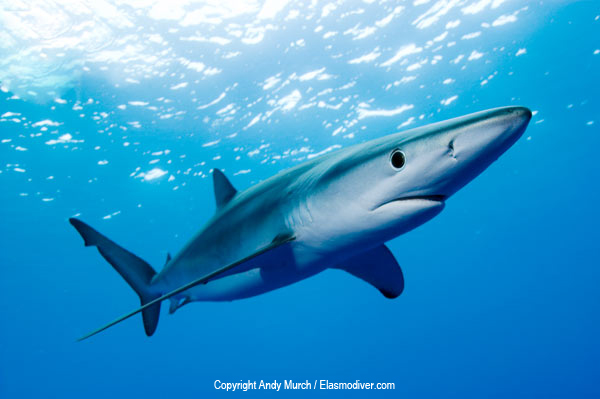 |
| blue shark |
Blue sharks, Prionace glauca to give them their Sunday name, have had a bad Press, unfairly in my opinion.
Those who will tell you this shark is dangerous are those who want to fish them from the sea.
In reality, they are timid beasts who would rather swim away from a confrontation.
If you are dying in the sea, perhaps from falling overboard or even, God forbid, part of a shipwreck, blue sharks may well congregate too close for comfort.
Say “Boo!” to them, and they will quickly disappear.
At 6 to 10 feet in length, they are probably bigger than you, but harmless in the main (in the main, get it?)
So, you are floundering in the water after a shipwreck and you see sharks approaching, how do you know if it is a blue shark?
The clue is in the name.
Blue sharks are blue – dark blue on top, light blue along the flank, and white underneath.
Streamlined, they are long, slim fish with big pectoral fins – those are the ones on the sides.
Pointed snouts and large eyes, and you have a typical blue shark.
Whatever you do, don’t play dead.
They happily feed off carcasses in the water, yours included.
This is what sharks do; it is their job to keep the oceans clean, and stinking carcasses have to be disposed off somehow.
And they need to eat.
While their normal diet consists of fish, squid, octopuses and other ‘sea things’, the stomachs of blue sharks have been known to contain blubber from whales and porpoises.
They hate tuna, apparently, so eat your fill before you end up shipwrecked.
An absolutely fascinating fact about blue sharks (to me anyway, sad I know) is that they swim in groups or schools or whatever you like to call them, of equal sized fish of the same sex.
Doesn't that remind you of school? Hockey, anyone?
Blue shark mothers give birth to anywhere between 4 to 135 pups per pregnancy, according to Wikipedia.
135?
Can you imagine the size of house you would need if that was your offspring?
Female blue sharks reach sexual maturity at only 4 or 5 years of age, which is exceptionally young for the shark family, as most of them follow a similar pattern to humans, not reaching maturity until they are in their teens, at least.
They are pregnant for between 9 and 12 months, according to current knowledge, and when the scientists have discovered the exact time, I will publish it.
Female blue sharks have thicker skin than their male counterparts.
No really.
Nothing to do with being insulted, although if they went to Britain and had 135 children, and needed social security to pay for the mansion they would need to live in, they’d need to develop one.
No, in the blue shark world, the male bites the female when he wants to initiate sex.
Seriously, this is true!
This only goes to prove what I said.
All we need to say to the highly strung and nervous blue shark is “Boo” and they disappear.
We should teach the female how to say it. Instead, God gave them thick skins, which grow thicker as they age.
Blue sharks are exceptionally dangerous to fishermen.
All sharks, when caught and are lying a boat’s deck, have the ability to twist their bodies round lightening quick to bite their captors, even when they look dead.
Blue sharks have honed this talent down to a fine art.
Fishermen are scared of them, and have declared them dangerous because if this.
One up to the blue shark! Go get ‘em!
I admit to not understanding the joy of fishing a sea creature that can’t be eaten (well it can, but it’s not the best) and can only be finned for the pleasure of certain Asian countries who choose to base their cuisine around something that even they admit is tasteless!
The blue shark is classed as near threatened on the IUCN list of endangered species which probably means it isn’t threatened at all. That’s not the point (it has 135 babies at a time), the point is they could be.
No comments:
Post a Comment